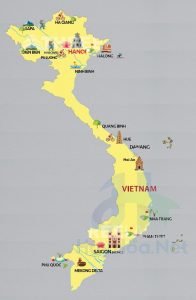The Socialist Republic of Vietnam is a stretch of land in S-Letter shape. Being located in the center of the Southeast Asian Region, and the Eastern part of the Indochina peninsula, Vietnam shares its borders with China to the North, Laos, Cambodia to the West, and the East Sea – Pacific to the East and South.
Table of Contents
Vietnam Geography
- Longitude: 102010′-109030′ East
- Latitude: 8o02′-23o23′ North
- Capital of Vietnam: Hanoi
Vietnam lies along Indochina’s east coast, bordering Laos and Cambodia to the west, and the People’s Republic of China in the north. You can divide Vietnam’s geography into four areas: the Highlands, the Red River Delta, and the Central Mountains; the Coastal Lowlands, and the Mekong River Delta.
Vietnam’s coastline is 3260 km long, meanwhile, the inland borderline is 4,510km. The mainland extends from the northernmost point to the Southernmost point is 1650 km (according to the birds flying stretch). From the Easternmost point to the Westernmost point, its width varies from 600 km (in the Northern part), 400 km (in the Southern part) to 50 km (in the Quang Binh province).
Vietnam Topography
The topography of Vietnam is lower from the Northwest to the Southeast. This can be clearly seen in major rivers’ flows. Three-quarters of Viet Nam’s territory is made up of hilly and low-mountain regions. The territory is made up of 85% of regions with an elevation below 1,000m above sea level.
Three-quarters of Vietnam’s territory is made up of hilly and mountainous regions. It has two major deltas, the first one is the Red River Delta, the early settlement region of ancient Viet people and either cradle of the wet rice civilization, the second one is the Mekong Delta – the biggest rice-growing area of Vietnam. There are thousands of large and small rivers in Vietnam, but only the two biggest river systems – the Red River in the North and the Mekong (or Cuu Long) river in the South are the most important.
Vietnam has a 3,260 km coastline with such nice beaches as Tra Co, Sam Son, Lang Co, Non Nuoc, Nha Trang, Vung Tau, Ha Tien, Phu Quoc… In some places, the mountains reach far to the sea, creating fantastic beauty like Ha Long Bay, which was listed by UNESCO as the World Heritage Site. 0ffshore in Vietnam’s sea area are thousands of islands and islets, scattering from North to South, among these are the two archipelagoes Hoang Sa (Paracel) and Truong Sa (Spratly).
Vietnam Climate
Vietnam is known for its tropical monsoon climate. Vietnam’s average temperature ranges between 70 and 95 degrees F year-round. The average annual humidity in Vietnam is around 85%
According to an International Commission on Climate Change report, Vietnam is among the most vulnerable to climate change. Because of its diverse geography, Vietnam is susceptible to weather phenomena such as storms, floods, and droughts. These events are likely to become more severe in the future.
Vietnam’s terrain extends over 1000km north to south. This gives it both a tropical and temperate climate. Every year, the entire country is affected.
Forests and forest lands account for a big area on the Vietnam territory and endow the valuable ecotourism sites such: as Ba Vi (Ha Noi), Cat Ba (Hai Phong), Cuc Phuong (Ninh Binh), Bach Ma (Hue), Cat Tien (Dong Nai), Con Dao…
See more weather in Hanoi to see the richness of the 4-season climate in Vietnam.

Vietnam is situated in the sub-tropical and tropical area having monsoon, abundant sunshine, rainfalls, and high humidity. At some high places in the tropic zone or in the high mountainous areas, the climate is rather similar to the temperate one. In general, there are two seasons in Vietnam: the dry cold (from November to the next April) and the rainy and hot one (from May to October).
Map of Vietnam
Vietnam is located in southeastern Asia. Vietnam is bordered by the East Sea and Gulf of Tonkin to the east, China to the north, and Laos and Cambodia to the west.
This is a map showing the most famous tourist destinations in Vietnam that are most interested and searched by foreign tourists on Google in 2026

Other information
Vietnamese Art
Vietnamese Villages
Vietnam Architecture

